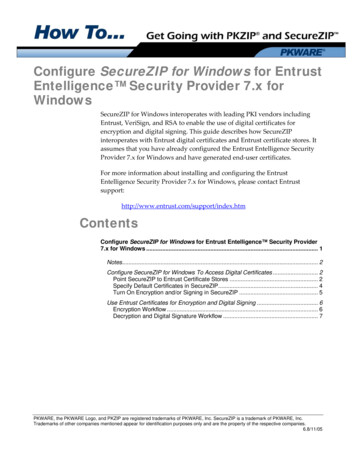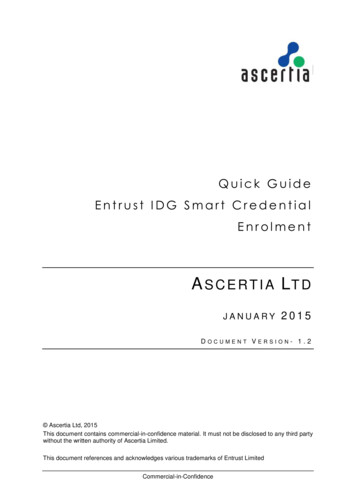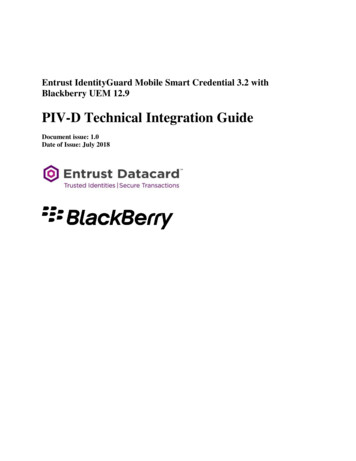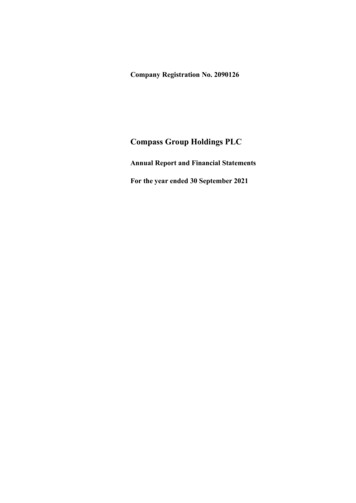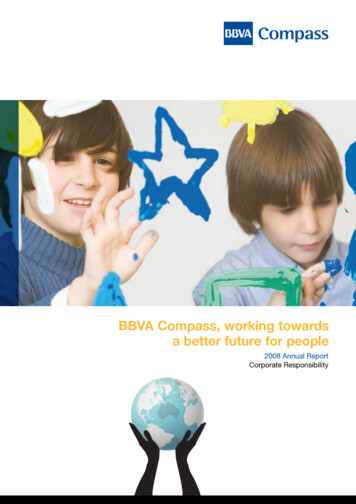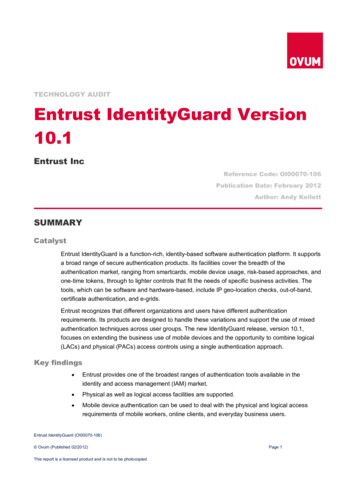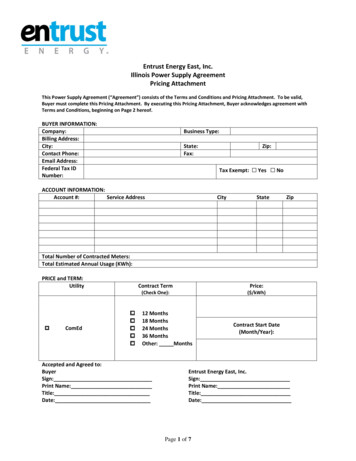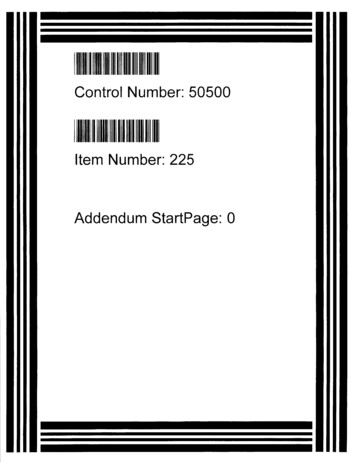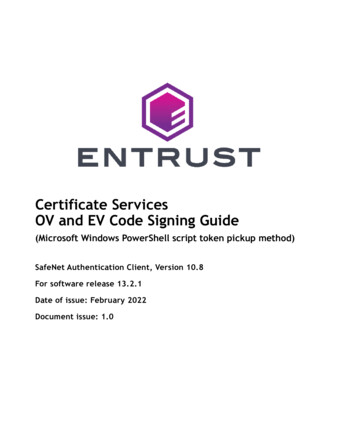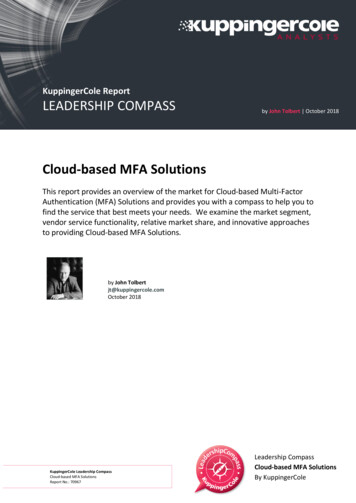
Transcription
KuppingerCole ReportLEADERSHIP COMPASSby John Tolbert October 2018Cloud-based MFA SolutionsThis report provides an overview of the market for Cloud-based Multi-FactorAuthentication (MFA) Solutions and provides you with a compass to help you tofind the service that best meets your needs. We examine the market segment,vendor service functionality, relative market share, and innovative approachesto providing Cloud-based MFA Solutions.by John Tolbertjt@kuppingercole.comOctober 2018KuppingerCole Leadership CompassCloud-based MFA SolutionsReport No.: 70967Leadership CompassCloud-based MFA SolutionsBy KuppingerCole
Content1 Introduction . 51.1Market Segment .71.2Delivery models .71.3Required Capabilities .72 Leadership.113 Correlated View.193.1The Market/Product Matrix . 193.2The Product/Innovation Matrix . 213.3The Innovation/Market Matrix . 234 Products and Vendors at a glance .254.1Ratings at a glance . 255 Product/service evaluation .275.1Entrust Datacard IntelliTrust. 285.2Gemalto SafeNet Trusted Access and Authentication Service . 295.3HID Global . 305.4Idaptive (formerly Centrify) . 315.5ID Data Web Attribute eXchange Network (AXN) . 325.6Microsoft Azure AD . 345.8Okta Adaptive Multi-Factor Authentication . 355.9One Identity Starling 2FA . 365.10OneSpan (formerly VASCO) Intelligent Adaptive Authentication. 375.11Ping Identity Ping ID . 385.12Symantec VIP . 395.13ThreatMetrix MultiFactor Authentication . 406 Vendors and Market Segments to watch .416.1AvocoSecure . 416.2CA Technologies . 416.3Duo Security . 416.4IBM . 426.5Iovation . 426.6NokNok Labs Strong Authentication SaaS . 426.7RSA Adaptive Authentication and SecurID Access. 426.8United Security Providers Secure Entry Server. 43KuppingerCole Leadership CompassCloud-based MFA SolutionsReport No.: 70967Page 2 of 53
7 Methodology.437.1Types of Leadership . 447.2Product rating . 457.3Vendor rating . 477.4Rating scale for products and vendors . 487.5Spider graphs . 497.6Inclusion and exclusion of vendors . 518 Copyright .52List of TablesTable 1: Comparative overview of the ratings for the product capabilities . 25Table 2: Comparative overview of the ratings for vendors. 26Table 3: Entrust Datacard’s major strengths and weaknesses . 28Table 4: Entrust Datacard’s rating . 28Table 5: Gemalto’s major strengths and weaknesses . 29Table 6: Gemalto’s rating . 29Table 7: HID Global’s major strengths and weaknesses. 30Table 8: HID Global’s rating . 30Table 9: Idaptive’s major strengths and challenges . 31Table 10: Idaptive’s rating . 31Table 11: ID Data Web’s major strengths and weaknesses . 32Table 12: ID Data Web’s rating. 32Table 13: Microsoft’s major strengths and weaknesses . 34Table 14: Microsoft’s rating . 34Table 15: Okta’s major strengths and weaknesses . 35Table 16: Okta’s rating . 35Table 17: One Identity’s major strengths and weaknesses. 36Table 18: One Identity’s rating . 36Table 19: OneSpan’s major strengths and weaknesses . 37Table 20: OneSpan’s rating . 37Table 21: Ping Identity’s major strengths and weaknesses . 38Table 22: Ping Identity’s rating . 38Table 23: Symantec’s major strengths and weaknesses . 39Table 24: Symantec’s rating . 39Table 25: ThreatMetrix’ major strengths and weaknesses . 40Table 26: ThreatMetrix’ rating . 40List of FiguresFigure 1: The Overall Leadership rating for the Cloud-based MFA market segment . 11Figure 2: Product leaders in the Cloud-based MFA market segment . 13KuppingerCole Leadership CompassCloud-based MFA SolutionsReport No.: 70967Page 3 of 53
Figure 3: Innovation leaders in the Cloud-based MFA market segment . 15Figure 4: Market leaders in the Cloud-based MFA market segment . 17Figure 5: The Market/Product Matrix . 19Figure 6: The Product/Innovation Matrix. 21Figure 7: The Innovation/Market Matrix. 23Related ResearchExecutive View: Entrust IdentityGuard for Enterprise – 71321Executive View: ForgeRock Identity Platform – 70296Executive View: Idaptive (formerly Centrify) Next-Gen Access Platform – 79036Executive View: Microsoft Azure Information Protection – 72540Executive View: Microsoft Azure Stack – 72592Executive View: OneGini Connect – 79031Executive View: One Identity Safeguard – 79042Executive View: Ping Identity’s PingDirectory – 70294Executive View: Ping Identity’s PingOne – 70288Executive View: Symantec CloudSOC – 70615Executive View: Symantec Advanced Threat Protection – 71155Leadership Brief: Why Adaptive Authentication Is A Must – 72008Leadership Brief: Mobile Connect – 71518Leadership Brief: Transforming IAM – not Panicking – 71411Leadership Compass: Adaptive Authentication – 71173Leadership Compass: Adaptive Authentication – 79011KuppingerCole Leadership CompassCloud-based MFA SolutionsReport No.: 70967Page 4 of 53
1IntroductionIdentity and Access Management (IAM) systems have continued to evolve significantly over the lasttwo decades. Increasing security and improving usability have both been contributing factors to thisevolution. Data owners and IT architects have pushed for better ways to authenticate and authorizeusers, based on changing business and security risks as well as the availability of newer technologies.Businesses have lobbied for these security checks to become less obtrusive and provide a better userexperience (UX). Many organizations are opting to deploy these capabilities in conjunction with theirIdentity-as-a-Service (IDaaS) solutions or as part of a “cloud-first” strategy.Cloud-based MFA is the process of using a SaaS solution to gather additional attributes about usersand their environments and evaluate the attributes in the context of risk-based policies. The goal ofCloud MFA is to provide the appropriate risk-mitigating assurance levels for access to sensitiveresources by requiring users to further demonstrate that they are who they say they are. This isusually implemented by “step-up” authentication. Different kinds of authenticators can be used toachieve this, some of which are unobtrusive to the user experience. Examples of step-upauthenticators include phone/email/SMS One Time Passwords (OTPs), mobile apps for pushnotifications, mobile apps with native biometrics, FIDO U2F or UAF transactions, SmartCards, andbehavioral biometrics. Behavioral biometrics can provide a framework for continuous authentication,by constantly evaluating user behavior to a baseline set of patterns. Behavioral biometrics usuallyinvolves keystroke analysis, mobile “swipe” analysis, and even mobile gyroscopic analysis.Cloud MFA Solutions can use multiple authentication schemes and authentication challengespresented to a user or service according to defined policies based on any number of factors, forexample the time of day, the category of user, the location or the device from which a user or deviceattempts authentication. The factors just listed as examples can be used to define variableauthentication policies. A more advanced form of Cloud MFA uses risk-scoring analytics algorithms tofirst baseline regular access patterns and then be able to identify anomalous behavior which triggersadditional authentication challenges. This can be referred to as dynamic Cloud MFA, yet it is difficultto categorize Cloud MFA products into dynamic or static Cloud MFA categories, since the strongestproducts are able to use a combination of both approaches. This is invariably a positive feature, asthere are use cases where the use of either static or dynamic Cloud MFA proves the mostappropriate, and both approaches are not without their limitations.KuppingerCole Leadership CompassCloud-based MFA SolutionsReport No.: 70967Page 5 of 53
A wide variety of Cloud-based MFA mechanisms and methods exist in the market today. Examplesinclude: Knowledge-based authentication (KBA) Strong/Two-Factor or Multi-Factor Authentication (Smart Cards, USB authenticators, biometrics) One-time password (OTP), delivered via phone, email, or SMS Out-of-band (OOB) application confirmation Identity context analytics, including IP addressGeo-locationGeo-velocityDevice ID and device health assessmentUser Behavioral Analysis (UBA)Many organizations today employ a variety of authentication methods. Consider the followingsample case. Suppose a user successfully logs in to a financial application with a username andpassword. Behind the scenes, the financial application has already examined the user’s IP address,geo-location, and Device ID to determine if the request context fits within historical parameters forthis user. Further suppose that the user has logged in from a new device, and the attributes aboutthe new device do not match recorded data. The web application administrator has set certainpolicies for just this situation. The user then receives an email at their chosen address, asking toconfirm that they are aware of the session and that they approve of the new device being used toconnect to their accounts. If the user responds affirmatively, the session continues; if not, thesession is terminated.Going one step further in the example, consider that the user would like to make a high-valuetransaction in this session. Again, the administrator can set risk-based policies correlated totransaction value amounts. In order to continue, the user is sent a notification via the mobilebanking app on his phone. The pop-up asks the user to confirm. The user presses “Yes”, and thetransaction is processed.Cloud-based MFA, then, can be considered a form of authorization. The evaluation of theseadditional attributes can be programmed to happen in response to business policies and changingrisk factors. Since access to applications and data are the goal, Cloud-based MFA can even beconstrued as a form of attribute-based access control (ABAC).The story above is just one possible example. Cloud-based MFA is being used today by enterprises toprovide additional authentication assurance for access to applications involving health care,insurance, travel, aerospace, defense, government, manufacturing, and retail. Cloud-based MFA canhelp mitigate risks and protect enterprises against fraud and loss.There are a number of vendors in the Cloud-based MFA market. Many of the vendors havedeveloped specialized Cloud-based MFA products and services, which can integrate with customers’on-site IAM components or other IDaaS. The major players in the Cloud-based MFA segment arecovered within this KuppingerCole Leadership Compass.Overall, the breadth of functionality is growing rapidly. Support for standard Cloud-based MFAmechanisms and the requisite identity federation are now nearly ubiquitous in this market segment;KuppingerCole Leadership CompassCloud-based MFA SolutionsReport No.: 70967Page 6 of 53
and the key differentiators have become the use of new technologies to step up the user’sauthentication assurance level or to collect and analyze information about the user’s session.1.1Market SegmentThis market segment is mature but constantly evolving, due to innovations in authenticatortechnology and risk analysis engines. We expect to see more changes within the next few years.However, given the surging demand of businesses and the need to provide better security, manyorganizations must implement either Cloud-based MFA or on-premises Adaptive Authentication ifthey have not already to help reduce the risk of fraud and data loss.Picking solutions always requires a thorough analysis of customer requirements and a comparisonwith product features. Leadership does not always mean that a product is the best fit for a particularcustomer and their requirements. However, this Leadership Compass will help identifying thosevendors that customers should look at more closely.1.2Delivery modelsIn this Leadership Compass, we consider cloud-based solutions only. See the recently releasedKuppingerCole Leadership Compass on Adaptive Authentication for similar solutions available for onsite deployment.1.3Required CapabilitiesVarious technologies support all the different requirements customers are facing today. Therequirements are Support multiple authenticators such as; Smart Cards, USB tokens Mobile apps and push notifications x.509 Biometrics OTP: phone, email, and SMS Integrate with IAM systems Perform real-time risk analysis of behavioral and environmental factors Support federation via OAuth2, OIDC, and SAML Facilitate compliance with existing and emerging regulatory frameworks, particularly EU GDPRand PSD2 (Revised Payment Service Directive) Adhere to policy-based access controls model so that IT departments and Line of Businessapplication owners can define risk appropriate authentication rules Integrate with security intelligence and forensic systems Provide administrators with management dashboards and configurable reporting Allow for delegated and role-based administrationKuppingerCole Leadership CompassCloud-based MFA SolutionsReport No.: 70967Page 7 of 53
Consider threat intelligence: subscription to 3rd party services that identify malicious IP addresses,URLs, patterns of fraud, and compromised credentialsCloud-based MFA is an evolution of yesterday’s IAM systems. Many organizations are feeling andresponding to the pressure to move away from just using usernames and passwords forauthentication. While many strong authentication options have existed for years, such asSmartCards, it is not often feasible from an economic perspective to deploy SmartCards or otherhardware tokens to every possible user of a system. Moreover, hardware tokens continue to haveusability issues. The mix of authenticators and associated user attributes that most commercialCloud-based MFA systems present are increasingly sufficient to meet the needs of higher identityassurance for access to sensitive digital resources and high-value transactions.It is important to understand the primary use cases that drive the requirements for Cloud MFA andAA products, as most of the major market players in this space tend to develop solutions tailored forconsumer or employee use cases. Some offerings are geared towards specific industry verticals.A good Cloud MFA solution needs to balance integration flexibility with simplicity. Today’s newestofferings in this area provide multiple authentication mechanisms, including many mobile options;risk engines which evaluate numerous definable factors which can be gathered at runtime andcompared against enterprise policies; and out-of-the-box (OOTB) connectors for the majority ofpopular on-premise and cloud enterprise applications.Integration with existing IAM platforms should be a primary factor in selecting a suitable product.The advantages of taking a single-vendor approach are primarily due to the potential licensing costsavings that arise from negotiating product bundle discounts. The advantages gained from theimagined greater ease of integrating disparate products from the same vendor rarely offer thereduced complexity promised by sales. All Cloud MFA solutions, almost by definition, require andsupport identity federation. While adaptive and multi-factor authentication may mitigate manyauthentication risks, no security solution is impenetrable. It is important to plan for rapid responsemeasures when security breaches do occur. Even the best defensive systems can suffer breaches.KuppingerCole Leadership CompassCloud-based MFA SolutionsReport No.: 70967Page 8 of 53
The criteria evaluated in this Leadership Compass reflect the varieties of use cases, experiences,business rules, and technical capabilities required by KuppingerCole clients today, and what weanticipate clients will need in the future. The products examined meet many of the requirementsdescribed above, although they sometimes take different approaches in solving the businessproblems.When evaluating the services, besides looking at the aspects of overall functionalitysize of the companynumber of customersnumber of developers partner ecosystem licensing models core features of Cloud-based MFAtechnologyWe thus considered a series of specific features. These functional areas, which are reflected in the spidercharts for each company in Chapter 5 include:Basic AuthenticatorsUsername/password: the most basic form, not recommended. Knowledgebased authentication (KBA): Security questions and answers that aredetermined at registration time. KBA is sometimes used in cases whereusers have forgotten their passwords, and need to have them reset, or as astep-up authentication method. KBA is not recommended, as many of theanswers to common questions chosen are not secrets.OATH One Time Passwords (OTP): OATH standardizes the use ofrandomized, single use passwords based on cryptographic hashes. OTPdelivery methods can be phone calls, email, or SMS (text) messages. As amore secure variation, OATH specifies time-limited OTPs, sometimesexpressed as TOTP. Due t o the fact that SMS OTP implementations are nottruly random, and attackers have discovered ways to circumvent SMS OTP,some organizations such as US NIST have deprecated the use of SMS OTP asa primary or step-up authentication method.Advanced AuthenticatorsFIDO 2.0, U2F, and UAF: The FIDO Alliance has defined two standards formobile and two-factor authentication. U2F applies to various hard tokengenerators, whereas UAF works in conjunction with mobile devices, such assmartphones. The FIDO framework allows device and softwaremanufacturers to utilize different technologies as the basis forauthentication events, such as PINs, biometrics, and cryptography. FIDO 2.0is the latest iteration and will likely surpass U2F and UAF in adoption in theyears ahead.SmartCards have small processors and secure storage devices that containdigital certificates and various user attributes. SmartCards can be used tofacilitate the highest levels of authentication assurance. SmartCards areused for not only authentication, both as primary and adaptiveauthentication methods, but also for physical access and digital signatures.Other types of hardware tokens employ similar technologies in differentform factors, such as RSA SecurID and Yubikeys.KuppingerCole Leadership CompassCloud-based MFA SolutionsReport No.: 70967Page 9 of 53
Biometrics is the term applied to any security technology, usually employedfor authentication and authorization, which functions by comparingregistered measurements to run-time measurements. Examples ofbiometrics include fingerprint, face, voice, iris, and behavioral. Biometricscan be used as primary authenticators or as policy-invoked adaptiveauthentication mechanisms.Mobile supportService providers are increasingly building their own mobile apps forauthentication and authorization. Mobile apps can offer a variety ofauthentication methods, from simple screen swipes to including biometrics(see below). Push notifications are a different type of mobile app which canbe used as a second factor in authentication or to authorize transactionsout-of-band. The ratings for mobile support include whether or not aproduct adheres the Global Platform Secure Element (SE) and TrustedExecution Environment (TEE) for Android, and whether or not the productutilizes Secure Enclave in iOS.Risk AnalysisFactors such as IP address, device fingerprints, device health assessmentgeo-location, geo-velocity, integration of 3rd-party threat intelligence, userbehavior profilingThreat IntelligenceSubscriptions to real-time feeds of known bad IP addresses, locations,proxies, malicious URLs, and compromised credentialsSSOSingle sign-on, generally to on-premise or LOB applications, usingfederation standardsSaaS integrationUse of federation technologies such as OAuth, OIDC, and SAML to allowauthenticated users to seamlessly access popular SaaS applications.Each of the categories above will be considered in the product evaluations below. We’ve also looked atspecific USPs (Unique Selling Propositions) and innovative features of products which distinguish themfrom other offerings available in the market.Please note that we only listed major features, but also considered other capabilities as well whenevaluating and rating the various Cloud-based MFA products.KuppingerCole Leadership CompassCloud-based MFA SolutionsReport No.: 70967Page 10 of 53
2LeadershipSelecting a vendor of a product or service must not be only based on the comparison provided by aKuppingerCole Leadership Compass. The Leadership Compass provides a comparison based onstandardized criteria and can help identifying vendors that shall be further evaluated. However, athorough selection includes a subsequent detailed analysis and a Proof of Concept of pilot phase, basedon the specific criteria of the customer.Based on our rating, we created the various Leadership ratings. The Overall Leadership rating provides acombined view of the ratings for Product Leadership Innovation Leadership Market LeadershipMICROSOFTENTRUSTPING IDENTITYTHREATMETRIXID DATAWEBHID GLOBALIDAPTIVESYMANTECOKTAONESPANGEMALTOONE IDENTITYFigure 1: The Overall Leadership rating for the Cloud-based MFA market segmentWe find several companies in the Leader section. Microsoft, Idaptive, and Entrust are at the top, showingstrong ratings in all Leadership categories.Okta, Ping Identity, Symantec, and ThreatMetrix are also in the Leader area. All seven of these companieshave strong cloud-based MFA offerings which need to be compared carefully when conducting productevaluations. Each one has particular strengths, and overall, they have excellent MFA capabilities.In the Challenger segment, Gemalto, HID Global, ID Data Web, and OneSpan, are all near the boundarywith the Leader section. Each one of these vendors takes a slightly different approach, and as such, hassomewhat different areas of focus for their Cloud MFA offerings. Rounding out the Challenger block areHID Global and One Identity.KuppingerCole Leadership CompassCloud-based MFA SolutionsReport No.: 70967Page 11 of 53
Overall Leaders are (in alphabetical order): Entrust Datacard Okta Idaptive Symantec Microsoft ThreatMetrix, a LexisNexis Risk Ping IdentityKuppingerCole Leadership CompassCloud-based MFA SolutionsReport No.: 70967Solutions CompanyPage 12 of 53
Product Leadership is the first specific category examined below. This view is mainly based on the analysisof product/service features and the overall capabilities of the various products/services.IDAPTIVEOKTAPING IDENTITYMICROSOFTENTRUSTSYMANTECTHREATMETRIXID DATAWEBONESPANGEMALTOONE IDENTITYHID GLOBALFigure 2: Product leaders in the Cloud-based MFA market segmentProduct Leadership, or in this case, Service Leadership, is where we examine the functional strength andcompleteness of services. Idaptive is at the high point, sharing the leadership section with Microsoft,Entrust Datacard, Okta, Ping Identity, and Symantec. For this Leadership Compass, the breadth ofauthenticator support along with configurability and usefulness of the adaptive risk engine are keydifferentiators. The vendors in the top spots have much to offer in both of those categories.In the Challenger section, ThreatMetrix is at the top, followed by ID Data Web, which is approaching theupper ranks. ThreatMetrix’ intelligence services drive it to the top of the Challenger segment, while IDData Web has numerous identity and attribute validati
Executive View: Symantec CloudSOC - 70615 Executive View: Symantec Advanced Threat Protection - 71155 Leadership Brief: Why Adaptive Authentication Is A Must - 72008 Leadership Brief: Mobile Connect - 71518 Leadership Brief: Transforming IAM - not Panicking - 71411 Leadership Compass: Adaptive Authentication - 71173
